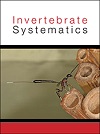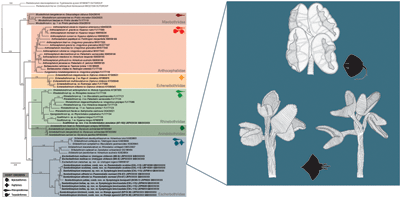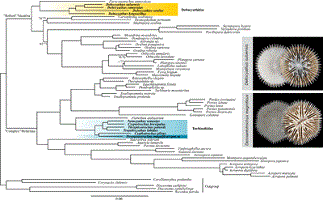Transfer of key species in the tapeworm order Rhinebothriidea to Semiorbiseptum and its assignment to the family Escherbothriidae greatly affects our understanding of how tapeworms evolved. Some species that parasitise skates have been assigned to a variety of rhinebothriidean genera without prior confirmation using phylogenetic analyses, thus obscuring patterns of host associations. We present evidence that skate-hosted rhinebothriidean taxa are restricted to the families Echeneibothriidae and Escherbothriidae. We believe our findings provide a robust foundation for future research into the diversification of tapeworms within the Rhinebothriidea and beyond. (Image credit: Veronica M. Bueno.)

Invertebrate Systematics
Volume 38 Number 4 2024
House centipedes are conspicuous yet often ignored myriapods for which little work has been conducted in southern South America. After examining recent and museum collections from Chile and Argentina, a new genus of scutigerid centipede, Edgethreua, is described with two new species from Central Chile and Argentinian Patagonia. A phylogenetic analysis of the new species using five molecular markers shows that the new genus does not cluster with any other described genus of scutigeromorph represented in molecular phylogenies. This new genus is likely sister group to a clade including the genera Lassophora, Ballonema and the subfamily Thereuoneminae, although another analysis suggests a position as sister group to Scutigerinae. (Image credits: picture, A. Porta; tree, G. Giribet.)
Antipatharians are important organisms in many benthic ecosystems. We analyse black coral molecular diversity in the Red Sea, examining 161 specimens occurring down to 627-m depth. Results confirm the presence of 4 families and 11 genera, highlighting the underestimated diversity of antipatharians in the basin, with seven new generic records and five molecular lineages of uncertain generic standing. The unresolved relationships recovered within the order emphasise the need for genomic-wide data integration and morphological reassessment to revise the order systematics effectively. (Image credit: Silvia Vicario.)
IS23041 Abstract | IS23041 Full Text | IS23041PDF (4.7 MB) | IS23041Supplementary Material (4.8 MB) Open Access Article
The family Deltocyathidae was recently erected to accommodate Deltocyathus species previously ascribed to Caryophylliidae but Deltocyathus magnificus was phylogenetically recovered within the family Turbinoliidae. Mitochondrial and nuclear sequence data, used for phylogenetic reconstructions, were obtained for 10 Deltocyathidae and Turbinoliidae species. Deltocyathus magnificus is moved to Turbinoliidae and ascribed to the new genus Dennantotrochus. A new mitochondrial gene order is described for Deltocyathus species. Macromorphological features indicate skeletal convergence and microstructural analyses demonstrate possibly conserved biomineralisation mechanisms. (Image credit: C. F. Vaga.)
Northern estuarine populations of Gammarus have given southern siblings the cold shoulder. Cryptic species have been discovered across a variety of organisms, from parasites to giraffes, with wide implications from human to ecosystem health. Our study supports the existence of a cryptic complex within the amphipod species Gammarus tigrinus and G. daiberi due to formation of the Labrador Current (c. 3 Ma). Gammarus tigrinus is highly invasive in Europe, highlighting the need to assess the potential for cryptic diversity of invading populations. (Image credit: Andrew G. Cannizzaro.)
The shrimps of Palaemonella and related genera (family Palaemonidae) were revised based on multigene phylogenetic analysis. The genus was revealed to be a diverse paraphyletic group. The shrimps of Eupontonia and Vir were therefore synonymised with Palaemonella. The Atlantic Cuapetes americanus was also transferred into Palaemonella, as well as Periclimenes rhizophorae (which had long been a synonym of C. americanus). The number of known representatives of Palaemonella has increased from 27 to 38 species. (Photographs by: left, A. Anker; right, I. Horká.)
Many scleractinian coral genera and species are within polyphyletic families or classified as incertae sedis despite advances in scleractinian systematics. Cladocora Ehrenberg, 1834, Madrepora Linnaeus, 1758 and Oculina Lamark, 1816 have had unresolved taxonomic issues. We found a close relationship between Oculina patagonica and Cladocora caespitosa, suggesting the need for family level taxonomic rearrangement, and a distant relationship between these species and Madrepora oculata, with evidence supporting placement of Madrepora in the resurrected Madreporidae Ehrenberg, 1834. (Image credit: Diego K. Kersting.)
IS23027 Abstract | IS23027 Full Text | IS23027PDF (1.9 MB) | IS23027Supplementary Material (2.5 MB) Open Access Article
The taxonomic status of the freshwater razor clam Novaculina siamensis Morlet, 1889 is determined using molecular and morphological analyses. Phylogenetic analyses placed the species separately from other currently recognised Novaculina species. Additionally, N. siamensis also possesses distinct morphological characteristics including fused, fringed siphons instead of separated, smooth siphons, as found in the type species of Novaculina s.s. Therefore Cenonovaculina gen. nov. is proposed to accommodate ‘N. siamensis’. (Image credit: Kongkit Macharoenboon.)












